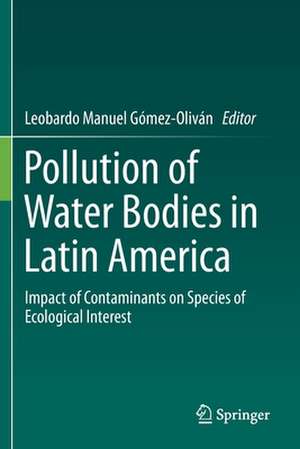Pollution of Water Bodies in Latin America: Impact of Contaminants on Species of Ecological Interest
Editat de Leobardo Manuel Gómez-Olivánen Limba Engleză Paperback – 6 ian 2021
| Toate formatele și edițiile | Preț | Express |
|---|---|---|
| Paperback (1) | 644.63 lei 6-8 săpt. | |
| Springer International Publishing – 6 ian 2021 | 644.63 lei 6-8 săpt. | |
| Hardback (1) | 650.86 lei 6-8 săpt. | |
| Springer International Publishing – 22 noi 2019 | 650.86 lei 6-8 săpt. |
Preț: 644.63 lei
Preț vechi: 758.38 lei
-15% Nou
Puncte Express: 967
Preț estimativ în valută:
123.35€ • 134.41$ • 103.94£
123.35€ • 134.41$ • 103.94£
Carte tipărită la comandă
Livrare economică 23 aprilie-07 mai
Preluare comenzi: 021 569.72.76
Specificații
ISBN-13: 9783030272982
ISBN-10: 3030272982
Ilustrații: IX, 366 p. 74 illus., 45 illus. in color.
Dimensiuni: 155 x 235 mm
Greutate: 0.54 kg
Ediția:1st ed. 2019
Editura: Springer International Publishing
Colecția Springer
Locul publicării:Cham, Switzerland
ISBN-10: 3030272982
Ilustrații: IX, 366 p. 74 illus., 45 illus. in color.
Dimensiuni: 155 x 235 mm
Greutate: 0.54 kg
Ediția:1st ed. 2019
Editura: Springer International Publishing
Colecția Springer
Locul publicării:Cham, Switzerland
Cuprins
Preface.- Historical findings on presence of pollutans in water bodies in Latin America and their ecotoxicological impact.- Toxicity produced by an industrial effluent from Mexico on the common carp (Cyprinus carpio).- Pesticide contamination in Southern Brazil.- Embryotoxicity and teratogenicity induced by naproxen in Xenopus laevis, species of ecological interest in Mexico.- Differential responses of biochemical and behavioral parameters in the native gastropod Chilina gibbosa exposed subchronically to environmental concentrations of two insecticides used in argentina.- Oxidative stress induced by water from a hospital effluent of the city of Toluca, Mexico on Hyalella azteca.- Evaluation of the toxicity of municipal effluents from a locality in the State of Mexico using Hyalella azteca as a bioindicator.- Analysis of heavy metals present on air through the toxicity analysis in water by the gas washer method, using the organism Daphnia magna.- Ecotoxicological Studies of Metal Pollution in Sea Turtles of Latin America.- Evaluation of the toxicity of an industrial effluent before and after a treatment with Sn-modified TiO2 under UV irradiation through oxidative stress biomarkers.- Effects of river pollution on its biota: results from twenty years studies in the Suquía River Basin (Córdoba, Argentina).- Effects found and induced by the presence of metals in species of the economic and ecological importance of Mexican aquatic environments.- Environmental Pollution by Hydrocarbons in Colombia and its Impact on the Health of Aquatic Ecosystems.- Biomonitoring of diffuse contamination in the Subtropical Region of Brazil: Multibiomarker Assessment in neotropical freshwater fishes.- Genotoxicity biomarkers in fish erythrocytes and water quality parameters.- Health diagnosis of the fish Scomberomorus cavalla from Tecolutla, Ver. México.- Histopathological assessment of organisms in ecotoxicological studies from Mexico.- Histopathological analysis of the intestine from Mugil cephalus on environment reference sites.- Impacts caused by manganese in the aquatic environments of Brazil.- Genotoxic effect of amoxicillin on peripheral blood of common carp (Cyprinus carpio).- Final conclusions.- Index.
Notă biografică
Dr. Leobardo Gómez-Oliván obtained a Ph.D. in Chemical-biological Sciences with specialization in Toxicology from the National Polytechnic Institute of Mexico in 2005. He has 20 years of academic experience as a full-time research professor. He has been a Full Research Professor at the Autonomous University of Estado de Mexico, Faculty of Chemistry, Environmental Toxicology Laboratory (Toluca, México) since 2005. His scientific interests include the toxicity of emerging pollutants, with a focus on pharmaceuticals and metals using stress oxidative, genotoxicity, citotoxicity, embryotoxicity and teratogenesis biomarkers on aquatic species such as Cyprinus carpio, Danio rerio, Xenopus laevis, Lithobates catesbeianus, Daphnia magna and Hyalella azteca. His expertise is documented by the number of original publications (87) with 785 citations (index H 17), and the supervision of 15 PhD thesis, 37 Master´s thesis and 60 Bachelor thesis. He is theauthor of 19 book chapters and has been the editor of four scientific books. Dr. Gómez has been recognized for his research and received numerous distinctions, such as: Honorific mentions in master's and doctorate degrees; winner of the first place research projects 2011, awarded by the Institute of Nutrition and Health Kellogg's; the prize for best research professor in the Chemical area in 2013 by the National Association of Schools and Faculties of Chemistry AC. He is also a member of the Editorial Board of the Journal Science of the Total Environment and Heliyon Environment, and has been a reviewer for several respected journals.
Textul de pe ultima copertă
The indiscriminate use of chemical substances in industrial processes and anthropogenic activities, have resulted in the release of these compounds into aquatic ecosystems through municipal, hospital and industrial discharges, producing various undesired effects on the environment and on species of ecological interest. These compounds, such as metals, pesticides, emerging pollutants and other substances are persistent and susceptible to biotic and/or abiotic transformations, yielding metabolites that can be more toxic than the original compounds. In this book, researchers from diverse environmental science disciplines share their experiences in countries such as Argentina, Brazil, Colombia and Mexico, and critically examine the problem of contaminants in aquatic ecosystems in Latin America, as well as the risks presented by their presence.
Caracteristici
This book is unique in Latin America, including research on bodies of water contaminated with various pollutants and their impact on species of ecological interest Provides an overview of the problem of pollution in aquatic environments in various Latin American countries Discusses the legal framework of the problem of contamination by various pollutants in aquatic environments in Latin America
